Our first long ocean passage found us departing in fog, almost getting mowed down by a fishing boat 50 miles out, then we couldn't find wind, got trapped in West Port, and finally departed the West Pit. If that wasn't enough we had another 3 day storm coming once we were 100 miles out. We diverted to Crescent Bay, went through some rough weather and fog, made new friends, toured the red woods, stopped in Fort Bragg, and then finally passed under the Golden Gate Bridge!
Every year a quiet migration down the West Coast of several dozen boats occurs. They come from cold damp cloudy places like Alaska, Canada and Washington. These sailors dream of sailing without foul weather gear, fleece jackets and polypropylene underwear. They long for water they can swim in without being hypothermic in less than 15 minutes.
For some, this leg south is no big deal. Experienced sailors who have sailed offshore many times probably pick their weather and fly down the coast.
But for timid neophyte sailors like us, this passage is our biggest challenge yet. San Francisco, as the crow flies, is about 750nm from Neah Bay (the last anchorage before making the "Big Left" down the coast). Some people like to break up the trip by staying close to the shore and stopping at the harbors along the way. Others like to stay close to the shore but without stopping for a fast passage straight down. Then there are people like us, who want to head offshore more than 100 miles and sail directly to San Francisco.
Staying inshore offers the advantage of lighter winds and smaller seas. However, there are many dangerous places along the coast where you can't stop. Also, most of the ports along the coast have river bars across their entrances. A bar is caused by the sediment flowing out of a river and building up at the mouth, making the entrance shallow. Normally this wouldn't be a problem, but the Pacific generates large ocean swells which grow steeper when they encounter the bar. When the tide changes and the current starts to ebb, theses swells can turn into deadly breaking waves.
During our trip down the coast during the Spring Tides (the strongest tide heights and current strengths of a given lunar cycle), the Coast Guard closed most of the ports every time the current started to ebb. So when sailing the inshore route, if you want to stop somewhere, you have to time the arrival at the bar entrance with the flood current and hope that the sea conditions are settled enough to cross the bar safely. Not a fun prospect when a storm is looming.
Those headed offshore have higher winds and bigger seas, but they don't need to worry about hitting any rocks. The prudent thing to do is head offshore when the extended weather forecast looks good.
That was our plan. Leave Neah Bay on a SW or WSW course until about 150 miles off then fly downwind with the prevailing NW winds and swell. So much for plans.
To prepare ourselves for sailing offshore, we started in long stages. First we moved on the boat to see how we liked it, and to learn about which things worked and what had to change. Then we did a 5 month trip up to Alaska and back. This helped us learn more about our boat, anchoring, weather, currents and ourselves. Both of those stages went very well, so we wintered over in Seattle to finish more projects (new engine, running rigging, building our wind vane, etc.) and to prepare for going offshore.
Our goal was to sail the Queen Charlotte islands and circumnavigate Vancouver Island before trying the leg to San Francisco. As is typical, our projects ran long, and we had to cut the Queen Charlottes out of the agenda (a very painful decision for us). But with only Vancouver Island to focus on, we had plenty of time to round the island and prepare for more offshore sailing.
Going around Vancouver Island was a good warm up for us. We sailed the exposed West Coast of the island in various conditions from 35 knot gales and seas of 3 to 4 meters (12 to 16 feet), to no wind and fog. Having survived that, and actually enjoying most of it, we felt ready for the long trip down the U.S. West coast.
We spent a month in Cadboro Bay, Canada, just NE of Victoria, getting some of the final projects finished (and redesigning bits of our wind vane steering system). The best months for sailing off the west coast are August and September due to the statistical lack of storms and strong winds. As August waned, we became anxious to get underway. After all this time planning and preparing, we were ready mentally to tackle the open sea.
We worked our way out to Neah Bay on the tip of Washington, struggling through gales and fog along the way. Once in Neah Bay, we planned on waiting for a good weather window before heading out. The key here is good. Having never done this long of an offshore leg covering so much distance, we weren't sure what a good weather window really looked like. Could we leave while there was a low moving through the far southern waters and still be ok? Should we wait until the entire 800 miles of coast has good weather? Or is there always some system moving through an area of the coast?
Part of the problem when we arrived at Neah Bay, was the unusual weather pattern over the Pacific this summer. The normal North Pacific High Pressure system was not there. The high was way down off the coast of California. All of the forecasts we had been monitoring seemed to have random wind and wave conditions. Everyday promised wind from a different direction. Our lack of experience with weather routing had us guessing at what to do.
So when the winds looked like they would be favorable for a passage down the coast, we departed. A misty fog greeted us as we started a close hauled course out of the Strait of Juan de Fuca. We heard large bulk carriers and tankers speed by in the nearby shipping lanes, but seeing them through the fog was next to impossible.
However, we could see an old friend from Lake Union, as we exited Neah Bay, waiting for the next millionaire to dump a small fortune into restoring her to her original "Sliver Bullet" gleam. Here the Kalakala is slowly rusting in peace.
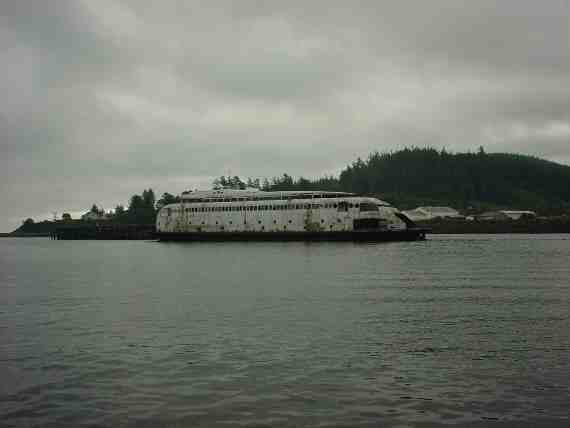
As we exited the Strait, we had to cross into the traffic circle where ships from Japan, Singapore, and other parts of the world converge to enter the traffic lanes. Tofino traffic on VHF 14 was busy warning ships and directing them on safe routes around each other. The traffic was so heavy, we decided to alert Tofino of our position and intentions. They informed us of two large ships that were in-bound and to keep a careful watch.
So far so good. Then about 10 miles off the coast the wind died. It didn't just go light, we were already ghosting along at about 2 knots in 4-5 knots of wind. No, the wind completely left the ocean. The seas were glassy with a low 2 foot ocean swell.
Amid all our planning, we hadn't thought of this -- no wind. As our sails flogged and beat themselves with a racket that no land lubber could appreciate, we wondered what to do. Over 850 miles were still left on our course, and we only had enough fuel to motor for about 250 miles. So as the sails banged with every passing swell, we felt madness slowly creeping up on us. After 3 hours, and slowly drifting back into the shipping lanes, we decided we would motor southwest and hopefully pick up some wind.
About 8 hours later into the night, the wind came back. We were finally sailing and our spirits soared again. We were on our way!
I'm sure you can see where this is going though. Two hours later, we were back to listening to the sails rattling and our floating home was again desperate for wind pressure. It was like being in a pitch black fun house. The type of fun house where there are loud laughs, screams, yelling, banging all at once - the sound of the banging sails would drive you mad. Such was the torture of sitting in the dark night, with no wind, rolling swells and 830 miles to go.
After we stretched our patience beyond its limits, we turned the engine on again. This time we motored directly south. Because the coast falls away to the east, heading south still moved us offshore and hopefully a more direct path to wind.
In the early morning hours, I spotted a large grey whale performing aerobatic tricks high above the sea. For a solid 30 minutes, I watched this monster explode out of the water and crash back in again sending plumes of white spray and foam 30 feet into the sky. I'm not sure what he was up to, but it was amazing to watch, from a safe distance that is.
After several more hours of no wind, followed by more hours of no wind, we started to get worried about using too much fuel. Looking for alternatives, we decided to head to Gray's Harbor on the southern end of Washington, where we could refuel and if necessary wait for wind.
Turning the boat southeast, we calculated our arrival time to cross the bar during slack water. To our chagrin we were going to willingly take the option we had carefully planned to avoid -- crossing a bar. To make it across the bar in time, we would have to really push the boat. Fortunately, with the lack of wind, there was hardly any swell making the bar conditions fairly benign.
After a long day of motoring, we entered Gray's harbor just before the start of the ebb, not the ideal time, but the conditions were smooth and we arrived with no problems. We tied up and caught up on our sleep.
The morning light revealed the pit we were trapped in. I can only say, "Yeeee doggie."
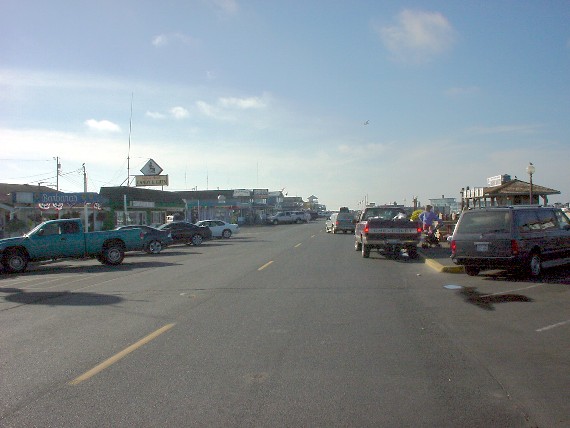
The morning's forecast brought bad news. Strong southerlies were expected off the central Oregon coast. So we decided to stay a day and see the town. Fifteen minutes later we were done. Westport, in Gray's Harbor, is a nice place to visit, or if you like to fish, perhaps a paradise. But for us, it was a prison.
Being vegetarian, there was nothing we could eat in town, and the grocery store was a good 2 mile walk away. We spent a lot of time at the beach, and walking around. The rest of the time, we tried to ignore the blood and gut festival all around us as sports fishermen and women gutted the days catch and joked about which body parts were still functioning.
By the third day, we were itching to leave. Even though a series of low pressure fronts were forecasted to pass over the Oregon coast, the wind strengths were only projected to be 20 knots at most. Not knowing any better, we started planning for an early departure. Just by sheer coincidence I happened across an old issue of 48 North and an article about sailing south by Diana Jessie, an experienced circumnavigator. She had one piece of advice that screamed out to me, "If you look at a long range forecast, the existence of a front from the south may bring wind from the south. Unless you really like sailing on the wind into the waves, sit tight until the front has moved on."
Oh, so that's a good weather window. With her advice in mind, the forecast began to sound like a cruel joke, "A WEAK COLD FRONT WILL MOVE INTO THE WATERS FROM THE NW ON SAT THEN INLAND ON SUN. A HIGH PRES RIDGE WILL TRACK OVER THE AREA ON SUN. A WARM FRONT WILL ENTER THE WATERS FROM THE NW SUN NIGHT FOLLOWED QUICKLY BY ANOTHER COLD FRONT...THEN MOVE INLAND ON MON. ANOTHER COLD FRONT WILL MOVE INTO THE REGION FROM THE W ON TUE."
All in all, we sat in prison for 10 days. When the fronts, lows and southerly winds finally disappeared from the forecast, the leftover swells from the storms were over 10' high. Not a big deal we thought, we've done that before. We fueled up and were getting ready to depart the dock when someone asked us if the Coast Guard had reopened the bar.
Huh? The bar is closed?! We hailed them on the VHF and they indicated the conditions were too hazardous for pleasure craft and the bar was closed. NOOOOOO! We slunk back to our slip in silence.
A shop in town had a 1000 piece jigsaw puzzle of the San Francisco bridge, and I joked to Sherrell that we could work on that over the winter here in Gray's Harbor.
The next day, the bar was open again, and a few sailboats had slipped out at 5am during slack. I tried to get up to make that early slack time, but we were both too nervous to sleep well so we decided to catch the slack around noon.
As the slack tide approached, we motored out towards the bar. We felt the large swells building. They were also getting eerily steep. They started to have that curling look to them. You know the look, when you're wading into the surf and suddenly a big wave is looming over you and you can feel that it is about to crumble on you.
I've had nightmares about this. Insanely large 100 foot waves curling up and falling on our little boat. Each wave was slowly increasing my level of anxiety. Imagine my relief when we were approaching the 2 mile long bar, just as the Coast Guard announced that "The conditions on the bar are rapidly deteriorating. It is no longer safe for small craft to navigate the bar. All pleasure craft vessels are advised to return to the harbor immediately as the bar will soon be closed."
The thought of staying in Gray's Harbor another day drove us on. I was so scared I puked. Well, not immediately, but progressively my stomach got tighter and tighter and after crossing the bar and entering deeper water, my stomach was the only thing I could think about. It was just a matter of time, I kept thinking.
The swells were big and rolling, but we were able to sail and things felt pretty good. But my stomach disagreed. I became nervous that I might be seasick the whole way, what would we do then? Nothing could take my mind off it, and soon my stomach took over my whole body and I found my stomach violating Annex V of the MARPOL Treaty and dumping food overboard within 12 miles of shore.
Naturally I quickly rallied. We were sailing on a great heading at an acceptable pace with light winds. Due to the large seas, the sails would fill hard and then flutter as we surged up and down the swells. But it wasn't too uncomfortable, so we happily started into our watch system of 3 hours on 3 off during the day and 4 on and 4 off during the night, so the person off watch at night could sleep longer.
As night set in, we found ourselves in the middle of a large fishing fleet. We had very little wind and could barely steer the boat because of how slow we were moving. Sherrell took the first watch and I ducked below for some sleep. About an hour later, Sherrell was calling for some assistance in dodging a boat. I looked out and she pointed dead astern of us.
A large set of lights were blazing in the dark night. Sherrell indicated they'd been rapidly approaching us for the last 10 miles and were now only 2 miles away. We tried lighting up our sails with a spot light, but they didn't alter course. We tacked the sails to alter our course but their speed was much greater and their 150' steel monster was barreling right for us. We tried hailing them on the radio several times, but they didn't respond. We then turned the spot light on their bridge and began flashing them and our sails in hopes they would see us sailing and alter course.
They didn't respond to any of our efforts but luckily we have an engine. We started it up, turned 90 degrees and floored it. About 3 minutes later we watched in horror as the oblivious boat zoomed over the spot we fled from. If we had had an engine problem or no engine, this would be a short story.
After that close call, we became much more aggressive with ships, tugs and fishing boats. It would later prove to be a life saving strategy.
Heading further offshore and into the azure blue water the commercial traffic disappeared, to our relief, and we were able to sail nicely down wind with the boom tied out and the genoa held out with our pole.
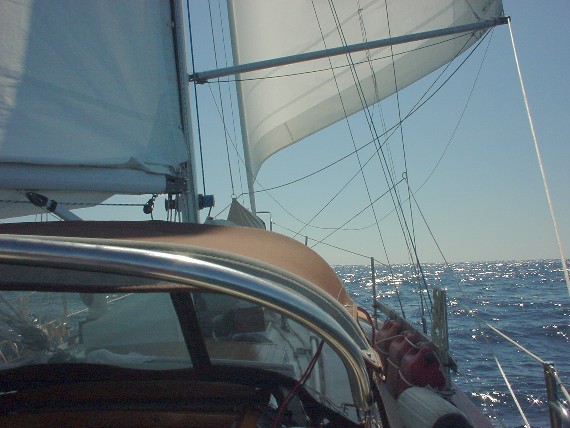
This far offshore we had no traffic to contend with and flying along all night we made about 95 miles in 24 hours. At this rate San Francisco was only about 4 days away.
The forecast looked good as the afternoon wound on. They were predicting about 10 knots from the NW. We had great winds, but they were a little more than what was predicted, so we decided to check the 96 hour weather fax. To our disappointment, it confirmed that another strong trough was moving across the coast and winds of 30-35 knots were predicted from Southern Oregon to San Fran for the two days we expected to pass through there.
With such nice sailing conditions as we were experiencing, it was hard to believe that we would have to suffer 2 days of heavy winds to get into San Fran. Rather than tempt fate, we made the extremely difficult decision of putting into port somewhere. Sherrell studied the charts and suggested we stop in Crescent City at the northern end of California as an alternative to sailing through 48 hours of near gale force winds and big seas.
Sadly, we jibed S.E. and started the long leg to Crescent City. Shortly after changing course, the wind started to build. We decided to drop the main and the genoa and sail with just the staysail. The wind was picking up and gusting to about 30 with waves of about 10 feet. By 5pm the wind was up to gale force and gusting higher. The waves were larger and started to break all around us.
We were taking a beating out there as the wind howled and the waves tried to crawl into the boat with us. The motion of the boat was very rough and it was hard just hanging on, let alone trying to sleep for the person off watch.
As the evening wore on, our exhaustion grew and we knew the the painful decision to divert to Crescent City and abandon our hopes of arriving in San Fran for now, was the right decision. Getting to Crescent City was going to take about 36 hours of sailing back inshore and south. As we sailed on, we watched all of our hard fought offshore distance slowly slip away. Since we were so far out (about 110 miles), it was going to take a while to get back inshore and south to California.
Meanwhile, we were still dealing with the gale off Oregon. All night long in the dark we hammered away at the seas as we rolled and pitched in the growing 12 to 15 foot seas. Often we'd hear a rush of water as a wave broke near us. Fortunately only a few actually tried to enter the boat, and they just left a brief spray of water. Enough to keep us awake and on guard for worse.
The wind built even more and the gusts were about 40 knots. We were making amazing time towards Crescent City. We covered about 100 miles in 18 hours.
To our great relief at about 10 am the wind started to let up. The seas died down to about 10 feet a few hours later. As we neared the shore, the fog started to thicken. We both thought, "Great, it's either a gale or pea-soup fog."
We were enveloped in a 65 mile thick fog bank and glassy seas. We had another day to get into Crescent City and we could barely see 40 feet. Steering solely by radar and GPS, we sat inside the boat and watched for traffic.
Sometime in the night, a blip appeared. A large slow moving blip. This usually meant a large fishing boat. We altered course 90 degrees, but we were somehow still on a collision course. We altered 180 degrees, but the blip kept getting closer. We continued on this course for several minutes until the blip was about 4 miles away, with no sign of us clearing it.
Since our boat doesn't produce a good radar target, there is a good chance that the boat didn't see us on his screen. We tried the spot light, but the fog made us wonder if it helped at all. So as he entered a zone 2 miles from us, we tried to hail him on the radio.
We tried several times, estimating his position, course and speed and calling to the "vessel at such and such position, heading ...." No response. This vessel was getting alarmingly close, about 1.5 miles away and closing. We altered course 45 degrees.
We tried hailing on different channels to get his attention, with no response. The next step was to notify the Coast Guard of our situation. We called them with our position, the situation and requested they try to contact the vessel. They didn't have any luck either.
As the ship approached within 1 mile, he seemed to stop closing in on us. Slowly the blip started moving past us. We sighed with relief and informed the Coast Guard that the vessel is clearing us and thanked them for their help.
After the blip moved about 3 miles from us, we returned to our course, and I collapsed back into the bunk to catch a few minutes of sleep before my watch was officially supposed to start.
We motored through that thick fog for miles and miles. It was so dense that large pools of water collected everywhere, like we were inside a black rain cloud. As the sun came up Sherrell took over the watch again as I crashed.
In the thick of the fog she had a tired visitor whom must have been lost, because we were still 20 miles offshore.
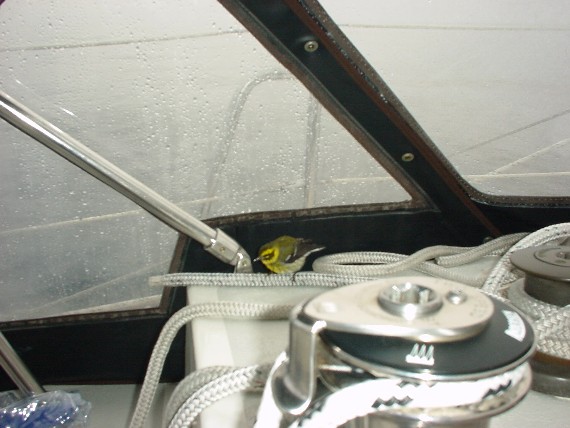
This little bird (possibly a type of warbler) was dead tired and soaking wet. He hid under the canvas covers and tried to stay warm while he could barely keep his eyes open. (You can see how thick the fog is in the picture, because you can barely see the water 4 feet away).
The bird got some rest, then started hopping all over the place. Sherrell's breakfast was the first victim. She set down her open faced peanut butter sandwich, only to see the little guy land in the middle of the peanut butter and lift his feet up and down in the goo with a confused look.
He then hopped around leaving peanut butter footprints all over the cabin top. Soon Sherrell had the little guy hopping around after her and even sitting on her shoulder. When Sherrell came up from making a new breakfast, she found him munching on a small fly that had been bugging me for the last 250 miles.
Shortly after that it was my turn on watch and Sherrell excitedly told me the tales of her new friend.
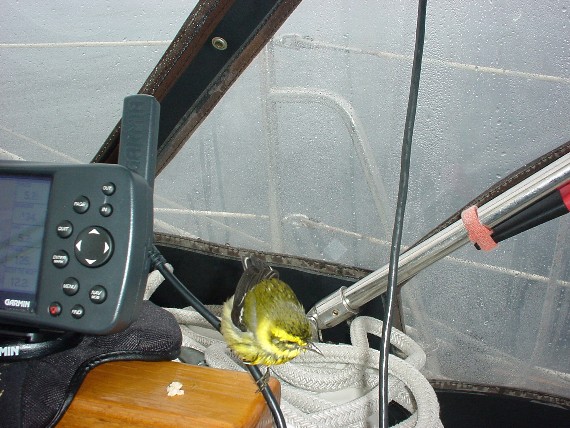
No sooner had I come out into the cockpit, he took flight out into the cold damp fog. Hopefully he got enough rest and food to continue on to find his way back to land, more then 15 miles away.
The fog lasted forever. All the way into Crescent City, then in the last 3 miles, it cleared up and we started to dry off. Entering California, we were greeted by a rousing cheer from the California Sea Lions.
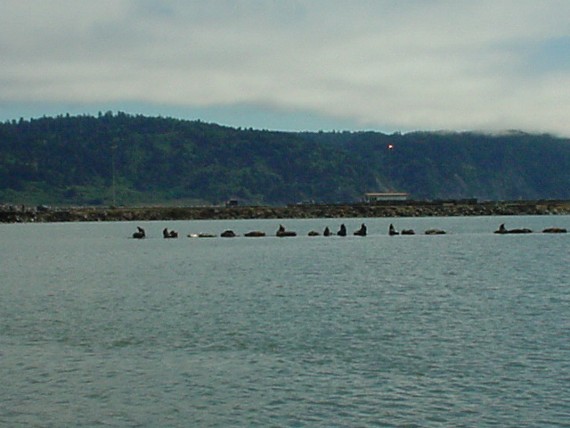
"ARRR ARRR ARRR ARRR ARRR ARRRR BUUURURUURURRRRRRPPPT!"
Despite this NOT being San Francisco, we were excited to be in California, and to get some solid sleep!
Once we refueled and tied up on the transient dock, we found there were several other sailboats (with even more arriving the following day) whom had heard the forecasts and decided to stay in port, or divert to Crescent City.
One boat, named Batwing, whom arrived the following day retold a story identical to ours (without the 20 hour long gale). They had also made the painful decision 100 miles out, to divert into port rather than battle a gale for two days outside of San Francisco.
After wandering around town for a while, we found out the library would loan us bicycles for a $20 deposit. Can you believe that?! Sherrell and I and our new 3 friends from Batwing set out to visit the redwood forests by bike.
The ride took us along a river and into huge redwood trees. Here's where we stopped for lunch.
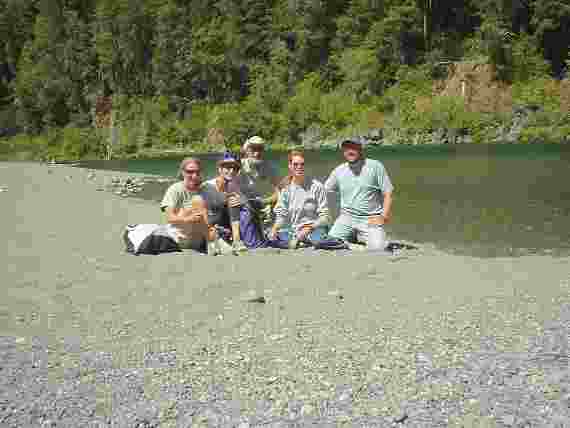
We walked our library bikes along the trail and over the foot bridge to the center of the forest as hinted to us by the park ranger, even though no bikes are allowed on these trails (see the red cross over the bicycle sign below?).
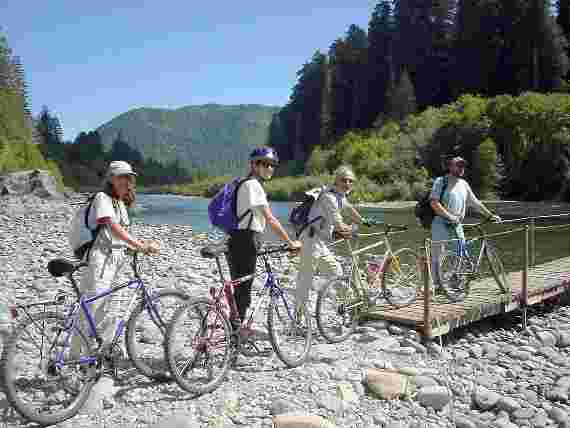
Crossing the river, GIANT redwood trees slowly revealed themselves to us. So large that all 5 of us barely could span the width of their trunks.
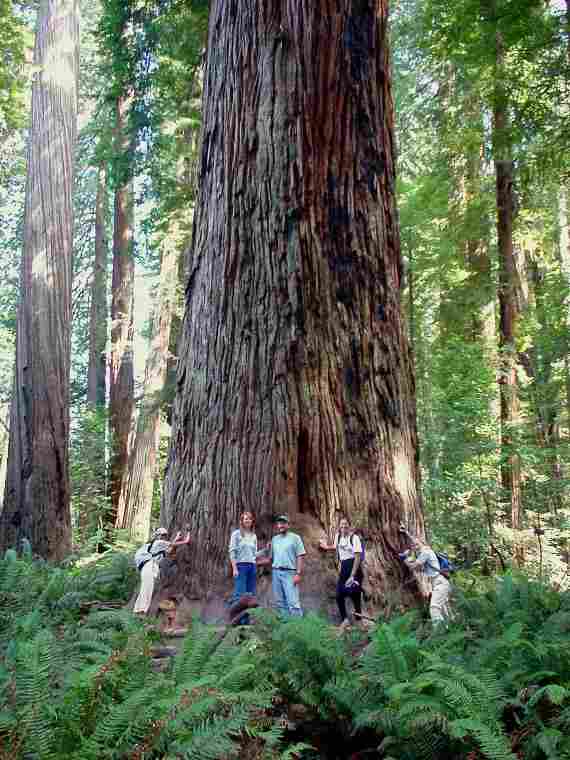
I looked small standing next to one of these giants. Some of these trees were thousands of years old.
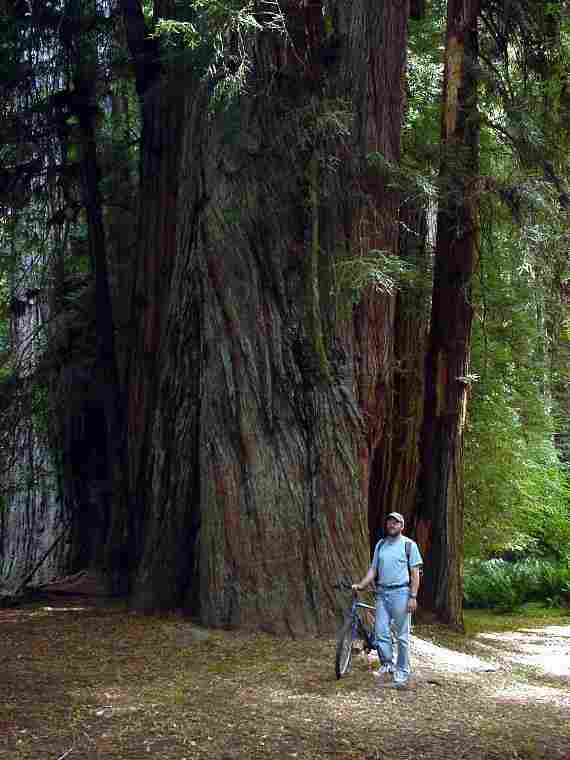
After the 18 mile bike ride, we were all feeling pretty good. It felt good to have made it all the way to California, and it felt great to not be stuck in Westport anymore.
We waited in Crescent City for about 4 days, and two of those days, the winds howled dramatically. We hunkered down inside the boat, smug in our decision to put into port.
As a weather window slowly started to appear, it looked like we could set out for San Francisco, only 250nm away. Our friends on Batwing had similar plans as us, and so we coordinated our departure times and set out to round Cape Mendocino (the last of the nasty bits of water before San Fran).
All went well until about 11pm when Batwing called out that they had a gear failure and were thinking of stopping at an anchorage south of the Cape. Their failure was unfortunate and wouldn't allow them to continue sailing, so they had to motor.
The seas were pretty rough and the wind was blowing about 20-25 knots. We were sailing along fast, but with Batwing's failure, we decided to slow down and try to keep with them throughout the night in case they needed some kind of assistance.
Early in the morning, the seas had calmed down and the wind started to die. They informed us they'd like to stop in Fort Bragg for the night and fix their gear. We altered our course and stuck with them.
The approach into Fort Bragg was a narrow 60 foot wide rock channel. We had heard a horror story of a large fishing boat getting turned sideways in the channel, so we were all nervous.
By the time we reached Fort Bragg the wind was gone, and the seas had really calmed down to almost nothing, maybe 4-6 foot swells. The entrance wasn't bad and if you squint just right, you could almost see the Golden Gate bridge.
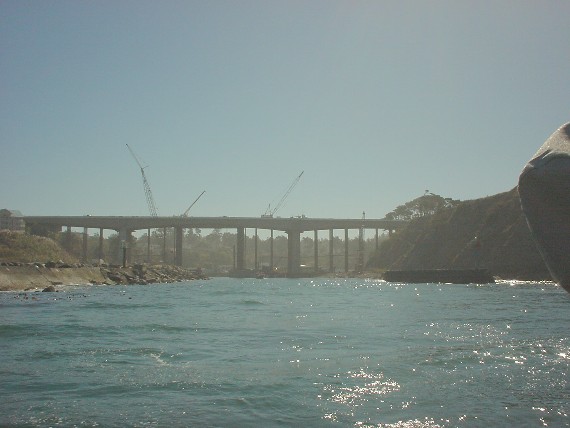
Well, maybe not but Fort Bragg was surprisingly nice. It was a small river that wound up the canyon to the marina where we tied up for the night. All night long we had the serenade of the sea lions, whom had recently arrived here and started lounging on the docks.
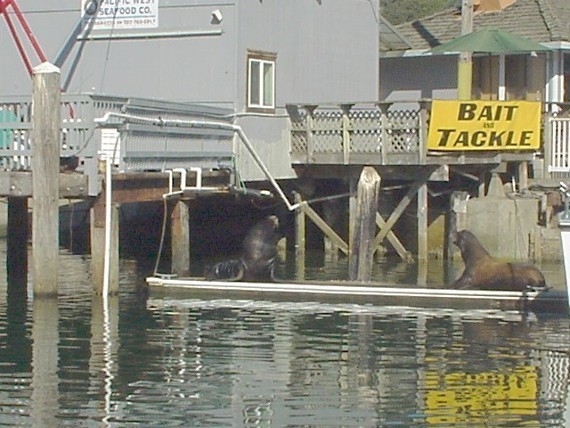
We fueled up the next day and set out for our final leg to San Francisco, about 150nm away.
All through the night we had windy conditions and rough seas. We scooted along with just a double reefed mainsail and we made great time. However, sometime around 1am a large ship appeared behind us and altered course in our direction.
We tried the spot light trick, but with no luck. We couldn't determine where he was headed, but it looked like it was going to mow us down. About a minute later it had closed in other 3 or 4 miles. Desperate to avoid him, and assuming he couldn't see our little boats on radar, we tried hailing him on the radio.
To our shock, he answered! He confirmed he could see us, and that "we will clear you 1.3 miles, no problem." After getting his heading and his speed, we quickly altered our course in hopes of clearing him by even more distance than 1.3 miles. It was a good thing we did, as he came within less than a mile of us, and we could see his huge bow looming over us in the dark night.
Relieved to see him pass us, we relaxed some and started searching the horizon for more lights. Suddenly a Stealth tug with a tow appeared about 5 miles away, heading in our direction. We watched on radar as our distance slowly closed on a collision course. Frustrated by all the traffic, we didn't waste anytime and got on the radio again.
After the third attempt to hail the tug captain, he finally answered and causally said, "Yeah, I've been watching you for a while. We might clear each other but it is going to be very close." Since he was only about 2 miles away, we requested his course and speed. Sure enough, we were on a collision course.
We quickly altered our course by about 60 degrees, despite the tug captain's suggestion of "You could probably just change by 5 degrees or so and you'll probably clear my tow." We crossed behind him by about 0.3 miles. It's a good thing we altered course based on our own judgment.
After all those close calls, we had very little traffic again. We had to dodge some buoys in the middle of the ocean, then Batwing had a panic attack as they thought the massive growing bright light on the horizon was going to run them down. I suggested to them that it might be the moon which was due to rise a few minutes earlier. It's deformed shape through the mountains and clouds gave them a start, but they seemed to the think the moon would clear them ok.
Butterflies started to grow in my stomach as we neared San Francisco and the sun started to rise. The wind was completely gone and the seas grew calmer and calmer as we rounded Point Reyes and approached the Gate!
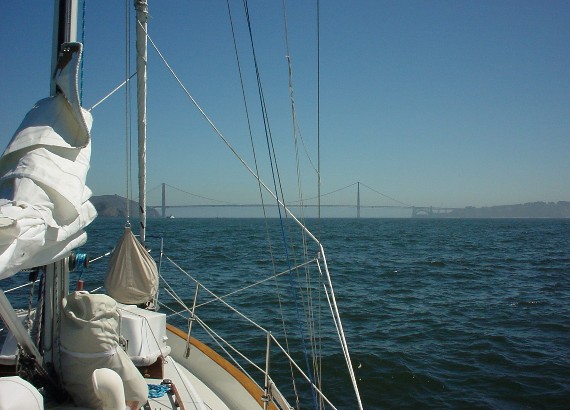
Wow what an exciting rush! Over 800 nm of sailing, 23 days since Neah Bay, we finally made it. The slowest passage and probably the most distance anyone has covered in recent times. Nevertheless we made it!
We entered the bay, rafted with Batwing for drinks, then anchored in Sausalito, tired and happy. Just look at our million dollar view of downtown from our anchorage.
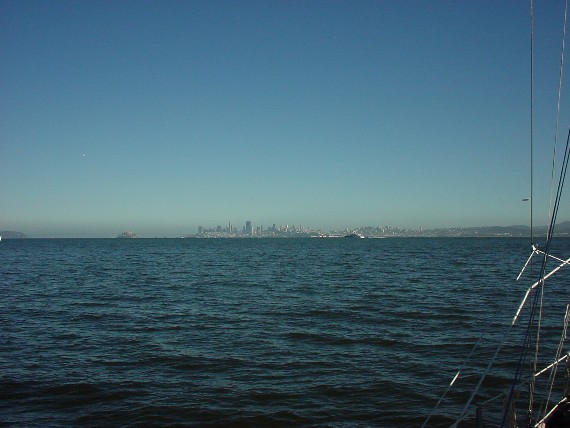
Once in Sausalito, we quickly oriented ourselves to the local scene and found out one of our favorite bands was giving a free concert on 9/11 for a festival called Power to the Peaceful.
What a cool welcoming! We caught the bus to Golden Gate Park and found thousands of people who, like us, were pissed off about our current political problems and were determined to change things.
To top it off, Michael Franti, from Spearhead (the band we wanted to see), was down with the crowd. Here you can see me doing "group yoga" in the park with Michael. Ha ha, which butt is mine?
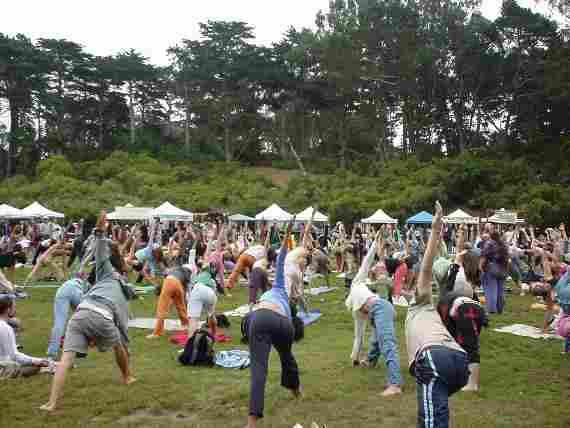
Actually after days of sailing, stretching out felt great, and it got us ready for a day full of dancing with 5 different bands. We couldn't believe how many people packed into the park. The estimates were around 50,000.
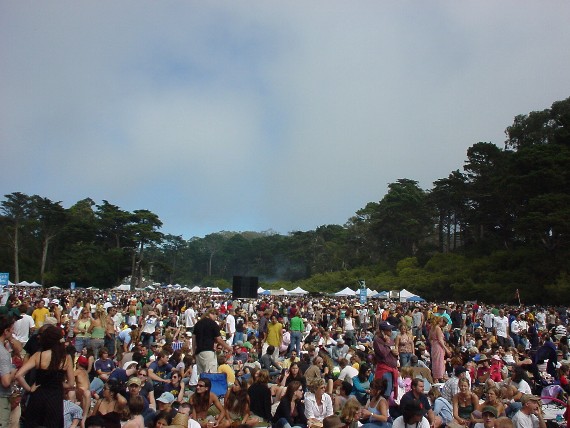
Spearhead was incredible and the best part, is all these people are voting.
So, our plans are pretty open right now. The toughest part of the trip is done. We'll hang out in the Bay Area for another week or so, then slowly cruise our way down the California coast.
Related Slog Links:

